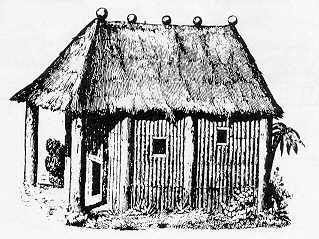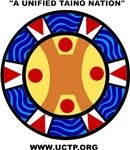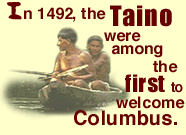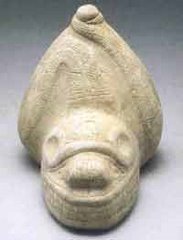Did you know - The traditional home of a Taino tribal leader or Kasike is called a kanei (caney); pronounced kah-nehEE. This dwelling was usually a central focal point in the community and faced the iukaieke (village) ceremonial and social grounds called “batei (batey)”. Besides being a residence for the village kasike (chieftain) and family, a kanei was sometimes used a ceremonial gathering place for community leaders including spiritual leaders. Like a typical dwelling called “bohio”, a kanei was traditionally made from local hardwood trees and was usually thatched with the Royal Palm. Unlike a bohio, which was often round, a kanei was typically rectangular, had a gabled roof, and a type of porch. - UCTP Taino News © 2007
Tuesday, December 04, 2007
A Taino Kanei (Caney)
Did you know - The traditional home of a Taino tribal leader or Kasike is called a kanei (caney); pronounced kah-nehEE. This dwelling was usually a central focal point in the community and faced the iukaieke (village) ceremonial and social grounds called “batei (batey)”. Besides being a residence for the village kasike (chieftain) and family, a kanei was sometimes used a ceremonial gathering place for community leaders including spiritual leaders. Like a typical dwelling called “bohio”, a kanei was traditionally made from local hardwood trees and was usually thatched with the Royal Palm. Unlike a bohio, which was often round, a kanei was typically rectangular, had a gabled roof, and a type of porch. - UCTP Taino News © 2007
Labels:
Bohio,
Canei,
Caney,
Kasike,
Taino,
UCTP Did You Know Files,
UCTP Taino News
Sunday, November 25, 2007
Kanoa is Taino
Did You Know - The first Europeans to travel to the islands of the Caribbean were greatly impressed by the kanoa (canoe) or boats constructed and used daily by the Taino islanders. Christopher Columbus wrote, "On every island there are many canoes of a single piece of wood; and though narrow, yet in length and shape similar to our rowboats, but swifter in movement. They steer only by oars. Some of these boats are large, some small, some of medium size. Yet they row many of the larger row-boats with eighteen cross-benches, with which they cross to all those islands, which are innumerable, and with these feats they perform their trading, and carry on commerce among them. I saw some of these canoes which were carrying seventy and eighty rowers." The kanoa were made from very large trees that were hollowed out over some months. Reminiscent of similar craft in Polynesia, the largest recorded 16th century Taino kanoa were said to hold over 150 people, they were ornately carved, and were used to travel long distances between the Caribbean islands and even into Bahamas, Florida, mainland of South America, Mexico, and Central America. Kanoa - a Taino and Lokono Arawak language term - is still used in Latin American Spanish, and is the origin of the English word canoe. - UCTP Taino News © 2007
Labels:
Bahamas,
Canoe,
Caribbean,
Central America,
Columbus,
Kanoa,
Mexico,
South America,
UCTP Taino News,
Yucatan
Thursday, October 25, 2007
Taino Body Stamps

Did You Know: With hand-crafted clay stamps, Taino people traditionally printed various designs on their bodies or on cotton cloth material. In a process comparable to temporary tattoos or henna-painting, pigments attained from plants such as Bija or Jagua and other natural resources were applied to the Taino stamps. The stamps were then pressed onto the body or cloth, imprinting the beautiful and varied designs. Body stamp designs could represent many concepts. While some designs could have a more traditional meaning among a certain community, others designs could be more of an individual expression. – UCTP Taino News © 2007
Labels:
Bija,
Body Painting,
Clay Stamp,
Henna Painting,
Jagua,
Taino,
UCTP Taino News
Wednesday, September 19, 2007
Behike
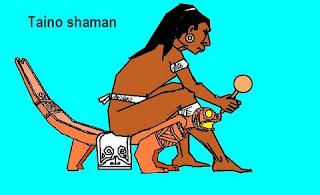
Did You Know - Among the Taino, the behike or shaman, was usually in charge of curing the ills in the community, thanks to his or her knowledge of medicinal plants and interaction with the spirit-world. Sometimes kasike (community leaders) took on a dual role of chief and medicine person. Kasike were also recorded as calling on behike for advice in major decisions affecting the well-being of the community. Alogn with the term behike (behique), other terms were used to identify this or a similar community role including bohitiu, buhiti, bohike, and piaie (piaman). -- UCTP Taino News © 2007
Image credit: Miguel Sague
Image credit: Miguel Sague
Labels:
Behike,
Medicinal Plants,
piaman,
Shaman,
Taino,
UCTP,
UCTP Did You Know Files,
UCTP Taino News
Wednesday, August 01, 2007
Day of the Puerto Rican Indian
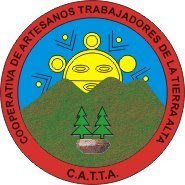
Did You Know - The official “Day of the Puerto Rican Indian” was inaugurated in a State Proclamation of the Interim Governor of the Commonwealth of Puerto Rico, the Hon. Fernando Chardón, on the 12th day of August 1970. Recently, the autonomous municipality of Jayuya (Office of Tourism) in cooperation with local Taino represented with a community organization called CATTA-COOP Inc. has celebrated this day with a weekend of special presentations and programs entitled "La Jornada Indigena". - UCTP Taino News © 2007
Monday, July 02, 2007
Baseball
Did You Know - Baseball as sport has its origins in the Taino batu game played in Cuba and throughout the Caribbean. Spanish chroniclers who traveled to the islands during the conquest and colonization periods provide evidence of this activity. The batu game was played at the batei/batey (ball field/court/ceremonial ground) and players used a ball made of resin and shaped leaves. As recorded in Cuba, in some cases, this ball was hit with an instrument similar to an oar or spade. According to Cuban linguists there is a relation in the origin of the words bate (bat) and batear (hit) with the corresponding words batey and batu used by the Tainos. – UCTP Taino News © 2007
See also:
See also:
Thursday, June 14, 2007
Mabodamaka
Did You Know - Kasike Mabodomaka was one of the Taíno leaders during the 16th century Indian Wars in Boriken (Puerto Rico). Mabodomaka’s Iukaieke (territory) extended through the present day pueblos of Camuy, Quebradillas, and Isabela. Before the European invasion this area was known as guahataka (Taíno for "The Water Ladle"). Local oral history states that when his warriors could no longer hold back the European invaders he led his people up the Guajataca River and disappeared into the Island's central mountain range. Route # 113 (Quebradillas - Isabela) has been renamed "Avenida Cacíque Mabodomaca" in honor of this great Kasike (Chieftain). - UCTP Taino News © 2007
Labels:
Boriken,
Cacíque,
Camuy,
Guahataka,
Guajataca,
Kamui,
Kasike,
Mabodomaka,
Taino,
Taino words,
UCTP Did You Know Files,
UCTP Taino News
Friday, May 25, 2007
Chico Spring: Taino Waterhole*
Did You Know - Chicho spring in Bayahibe, Dominican Republic is one of four individual caverns that makes up the "Padre Nuestro" complex, which is a series of water-containing sinkholes in limestone of the Pleistocene origin. The entrance of Chicho spring is a steep slop that descends 25m to a freshwater pool in an underground chamber. The chamber is 30m wide and 20m high and has some sunlight in the mouth of the cave during the day. The underwater pool itself is 8m wide by 20m long and has depths of 8m. The spring has no measurable flow and little runoff resulting in little sedimentation. It has crystal clear water that stays a constant 25 C year round. Currently the complex is used by a local resort for its water source, but this site was also used long ago by the local Taino people for gathering fresh water. Archaeologist used scuba equipment to help them with excavations in Chicho spring. They collected artifacts on several reconnaissance dives, producing an assemblage of 30 ceramic pieces. All of the ceramics are bottle forms and the assemblage included one intact vessel. Taino water bottles in the southeastern region of Dominican Republic are typically heart-shaped with zoomorphic or anthropomorphic heads attached on both sides. This bottle form is locally known as potiza and 28 of the ceramics followed this form. The artifact seen above is relatively simple, but the more elaborate potizas in museum collections show that the two lobes actually represent female breasts and is termed mammiform. The two non-potiza ceramics recovered were pieces of bottles with different forms, one with a double-bulbous form and one with a modeled, figurine-like body. - - UCTP Taino News © 2007
*See more photos of the ceramics excavated at Chico Spring at:http://lisahopwood.com/ceramicphotos.html
Tuesday, April 10, 2007
Batu is a Taíno Ball Game
Did You Know: Batu is an ancient Taíno ceremonial ball game, which has been regaining popularity in the Dominican Republic and Puerto Rico over recent decades. Similar to ball games played by Indigenous Peoples in Mesoamerica, opposing teams use a rubber ball in ways reminiscent of volleyball but without a net or the use of their "hands." 15th-century European colonizers marveled at the agility of Taíno ball players, men and women, and the game's main piece of equipment - the rubber ball. Europeans had never before seen this Taíno innovation. The Taíno used the sap/latex from certain trees, together with plant fibers, to construct the ball. Batu was used for conflict resolution, as well as for the fulfillment of certain spiritual and secular community needs. Besides oral tradition, the importance of Batu in ancient Taíno society is affirmed by the number of ball courts or batei "uncovered" by archeologists throughout the islands. The batei (batey) or ceremonial grounds were used not only for the game of Batu but for community ceremonies called "areito". The revival of Batu ball games have been documented in Puerto Rico (Jayuya) and the Dominican Republic (Azua) since the 1970s. The community members in the Dominican Republic currently maintain three Batu leagues each with their own leaders.- UCTP Taino News (c) 2007
Thursday, March 01, 2007
Guayaba is Taino

Did You Know - Guaiaba (Guayaba) is the Taino word for the guava fruit, which is native to the Caribbean, Central, and South America. The fruit is edible, having a sweet soft interior with a thin delicate rind. The rind varies in color from green to light green or yellow in its mature or "ready to eat" state. When eating guava fruit two things you will notice is that it has small hard seeds as you bite into it as well as a distinctive aroma. Guava is said to be a good source of Vitamins A, B, and C and is a common flavor of juices and desserts in the Caribbean. Guaiaba leaves have been used as a remedy for diarrhea and the leaves are considered to have antimicrobial properties. The same anti-diarrheal substances which are useful in "folk medicine" may also cause constipation in the case of consumption of large amounts of guava fruit. In Cuba, guaiaba leaves are sometimes used in barbecues providing a savory, smoked flavor to the meat. According to Taino oral tradition, the chief or guardian of Koaibei (Coaybey), the Taino spirit world, is named Maketaurie Guaiaba. Taino oral tradition also states that ancestral spirits or hupia leave Koaibei in the evenings, sometimes taking the form of bats who feed on the guaiaba fruit. - UCTP Taino News (c) 2007

Wednesday, February 28, 2007
Quiskeya is a Taino Name

Did You Know: Quisqueya or Kiskeia (Kiskeya) is one of the Taino names for the island of Hispaniola, or what is now the Dominican Republic and Haiti. The name, is said to mean "Mother of the Earth," and is still used to this day. Many Dominicans still refer to their island as La Isla Quisqueya, and refer to themselves as Quisqueyano. – UCTP Taino News (c) 2007
Click on Map for Larger View
Click on Map for Larger View
Labels:
Dominican Republic,
Haiti,
Hispaniola,
Kiskeia,
Kiskeya,
Quisqueya,
Quisqueyano,
UCTP Taino News
Tuesday, January 09, 2007
Taíno Warriors
Did You Know: The Taíno were well-renowned for their observance of a culture of peace, yet they did not willingly succumb to Spanish colonization. In fact, not long after Columbus’s arrival, Taino people on the island of Bohio (now Haiti/Dominican Republic) successfully revolted against the first Spanish attempts to conquer their ancient island homeland. This Taino offensive against the Spanish invaders was carried out as early as in 1492 with the destruction of the Fort Navidad following Columbus’ return to Spain. Upon his return to the fort, Columbus learned that the Taino had killed all his men in a swift military operation led by Kaonabo (Caonabo), a chieftain or Kasike of Maguana, an indigenous territory near the center of the island. The rape of Taino women by the Spanish colonizers was among the main reasons the Taino turned to hostility. Kaonabo led a resistance against the Spaniards until he was finally captured in 1494 and imprisoned. Following Kaonabo's imprisonment, his brother Manikateh mounted an unsuccessful attempt to free him and was also imprisoned. According to Spanish sources, Kaonabo is said to have perished at sea while on route to face the Spanish Crown in 1496. - UCTP Taino News (c) 2007
Friday, January 05, 2007
Being Called Indian...
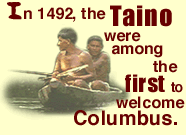
Did
You Know - The
Taíno were the first Indigenous Peoples of the Western Hemisphere to be called
“Indians”. According to historic sources the misnomer was applied by
Christopher Columbus on his first trip to the Caribbean in 1492. This was the
beginning of a legacy of “first” for this Caribbean Indigenous First Nation.The
word "Taíno" means "good people" in the Taíno language
(Tai = good and "no" = is a plural suffix used in this case to mean 'people').– UCTP
Taino News © 2007
Subscribe to:
Posts (Atom)
